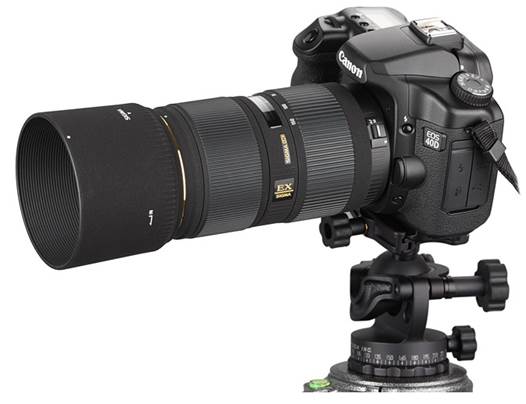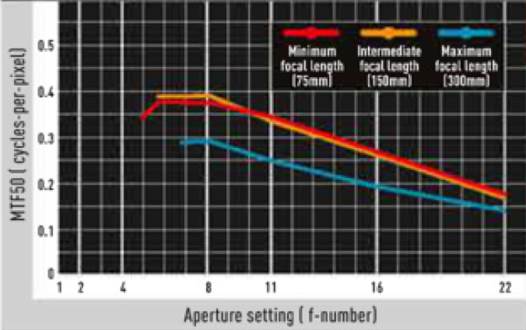Price: $1,268.5
Fast telephoto zoom designed for APS-C
DSLRs
Sigma's new 50-150mm is designed for use on
an APS-C DSLR, delivering a 35mm focal length equivalent of 75-225mm on a DSLR
with a 1.5x crop factor, providing a short to medium telephoto range with a
fast maximum aperture of f/2.8

Sigma
50-150mm f/2.8 EX DC DS HSM
Designing a zoom of such proportions for
comfortable use can be tricky and Sigma’s engineers clearly envisage that this
lens will be used with its removable tripod collar attached as this provides a
comfortable platform when supporting the lens in the hand. The manual-focusing
ring is forward of the collar but is slightly too close for easy reach; the
more distant and much broader zoom ring on the other hand, is perfectly placed
and offers just the right amount of resistance.
There is a focused-distance window behind
the focusing ring, beneath which sits a pair of sliders to set the focusing
mode and to control the Optical Stabilisation system. Both focusing and zooming
are fully internal, with no disturbance of the manual-focusing ring and without
any extension or rotation of the lens barrel.
Using the lens without its tripod collar
means taking a slightly more rearward grip, to maintain balance, and brings the
manual-focusing ring to finger-tip touch but makes the zoom ring a shade too
far forward for easy reach.
The six SLD (Super Low Dispersion) elements
that are used to provide apochromatic correction do a reasonable job but there are
traces of color fringing at both ends of the zoom range. MTF testing at three
focal-length settings produced three separate curves: the results at 50mm were
very good; at 85mm they were excellent; at 150mm the figures dropped and the
lens was a little weak at wide apertures.
Out in the field the size and weight of this
lens can become burdensome but no more so than the full-frame 70-200mm
equivalent. The padded carrying case is a welcome inclusion that provides
excellent protection and a constant home for the lens hoof if it is detached
from the zoom. Needless to say, the tripod collar is a huge advantage in terms
of balancing the lens-and-camera for use on either tripods or monopods.
When treated as the APS-C equivalent of a
full-frame 70-200mm f/2.8 lens, the 50-150mm zoom looks very attractive but its
maximum aperture is in fact one F-stop behind that of the full-frame version.
Nevertheless, the 50-150mm zoom is a useful
and well-priced lens in its own right. It would be nice if it were slightly
smaller and lighter as it’s noticeably larger than its predecessor. It’s
actually almost identical in size to the 70-200mm f/2.8 from Sigma, but as it
stands it feels robust and durable. The AF system generally performed well but
occasionally hunted at 150mm. that, and minor color fringing, aside this is a
very capable and feature-packed lens that is bound to appeal to a lot of APS-C
DSLR owners.
Image quality
While a good optical performance overall,
it wasn’t quite as sharp as we’d like at the long end of the zoom.

Lens performance through aperture range

Above:
Consistency appears to be lacking though even the lowest curve represents a
good MTF performance. The exception is when the lens is used at 150mm, close to
maximum aperture
Pros – Constant f/2.8 aperture
·
Sturdy build
·
Internal focusing
Cons
·
Weaker MTF wide-open at 150mm
Key specs
·
Maximum aperture: f/2.8
·
Minimum aperture: f/22
·
Lens mount: Sigma, Canon, Nikon, Pentax, Sony
·
Number of Blades: 9
·
Image Stabilisation: Yes
·
Optics: 21/15
·
Minimum focus: 80cm
·
Filter size: 77mm
·
Lens hood: Yes
·
Width: 86mm
·
Length: 198mm
·
Weight: 1340g
Score: 89%
Olympus M.Zuiko Digital ED 75-300mm f/4.8 – 6.7
Price: $991
Ultra-long telephoto zoom for Micro
FourThirds
Anybody who thinks that Micro FourThirds
systems are all about ultra-compact bodies and lenses is likely to be surprised
by the size of the Olympus 75-300mm zoom. Not only is the lens longer than the
width of an Olympus PEN Mini body, but also it barrel diameter is greater than
the camera’s height. As a result, this particular pairing looks less like a
camera with a lens on the front than it does a lens with a camera at the back.

Olympus
M.Zuiko Digital ED 75-300mm f/4.8 – 6.7
That may sound like an esoteric distinction
but when the camera is used on a tripod the lens barrel is very likely to foul
on the mounting plate, potentially making the zoom ring impossible to rotate.
Fortunately, this problem is largely alleviated when a larger Olympus OM-D body
is used.
The lens itself, which is available in a
choice of black or silver finishes, has an uncluttered design. The barrel is
dominated by a broad zoom ring that fills more than the centre third of the
lens. A much narrower manual-focus ring sits at the front of the lens but is
still within easy reach. The zoom ring has a 900 movement and feels
slightly heavy, probably because of the amount of glass the gearing has to
move. The focusing ring rotates continuously but lacks smoothness. Automatic
focusing is truly silent, allowing Olympus to claim the zoom is optimized for
both stills and movie use.
There are no other controls or markings on
the lens as all other settings are made via the host camera. One such setting
is the activation and mode of image stabilization. Interestingly, and for the
first time, the MTF results obtained with image stabilization switched-on
exceeded those recorded with it switched-off.
Despite the use of low-dispersion and
high-refraction elements, chromatic aberration was noticeable at longer
focal-lengths during testing. There were also times when the lens was slow to
focus: again, this was most common at longer focal-lengths. These two problems
restrict the enormous power of a zoom that extends to the equivalent
field-of-view of a 600mm lens mounted on a full-frame camera.
Similarly, attempting to use a
600mm-equivalent lens on a body that lacks a viewfinder, is very awkward indeed
as the slightest movement of the camera can make the intended composition
disappear from view.
Overall, this is a hard lens to
characterize. When used with an OM-D body it works well but there is no
escaping the fact that chromatic aberration is an issue at longer focal
lengths. Attempting to use the lens with a viewfinder-less body, on the other
hand, can be very frustrating. Then there is the price: $991 is a significant
sum and some potential purchasers may opt for the Olympus 40-150mm f/4 – 5.6
lens instead by virtue of the fact that it is smaller, lighter and costs just
$317. But, of course, the 75-300mm zoom offers even more pulling power and in
some situations that may be the decisive factor.
Image quality
Shot with a OM-D the viewfinder made
composition much easier than relying on the rear screen of a PEN-series camera.

Lens performance through aperture range

Above:
The 300mm setting clearly displays a weaker set of MTF results but even so the
figures are good down to f/11, which is only one F-stop less than for the other
focal-lengths tested
Pros – 600mm equivalent focal-length
·
Quiet autofocus
·
Size
Cons – Color fringing
·
Price
·
Plastic finish
Key specs
·
Maximum aperture: f/4.8 – 6.7
·
Minimum aperture: f/22
·
Lens mount: Micro Four Thirds
·
Number of Blades: 7
·
Image Stabilisation: In-camera
·
Optics (elements/ groups): 18/13
·
Minimum focus: 90cm
·
Filter size: 58mm
·
Lens hood: No
·
Width: 70mm
·
Length: 116mm
·
Weight: 430g
Score: 87%